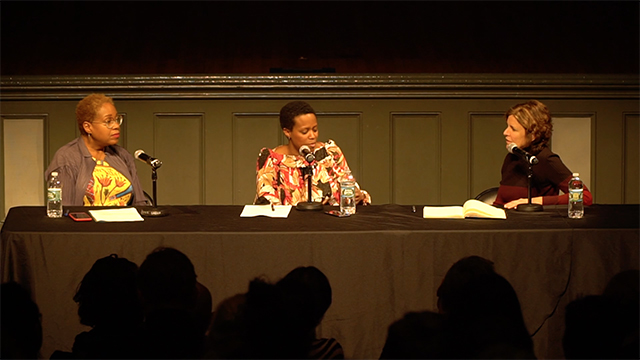Contested Ground: Design and the Politics of Memory
Tuesday, January 22, 2019, 7 - 9pm

A conversation with Jeanne Gang, Amanda Williams, and Mabel O. Wilson.
How can historians, architects, and designers make visible and physically memorialize lost histories—what the founding Director of the Smithsonian’s National African American Museum of History and Culture, Lonnie Bunch, refers to as “histories that hide in plain sight”? What are the design implications of spatializing the politics of memory? To whom will these memorials speak, and what do they tell us about our shared past? A three-way conversation between Jeanne Gang, Amanda Williams, and Mabel O. Wilson will explore these questions based on their research and design projects addressing public space, race, and cultural memory.
The discussion will include an exploration of the thematic links in three recent projects: Williams’ Thrival Geographies (In My Mind I See A Line), Gang’s Stone Stories—both created for the 2018 Venice Architecture Biennale US Pavilion, Dimensions of Citizenship—and Wilson’s Memorial to Enslaved Laborers at the University of Virginia (designed in collaboration with Höweler + Yoon).
Jeanne Gang is the founding principal of Studio Gang, an architecture and urban design practice based in Chicago with offices in New York, San Francisco, and Paris. Through projects ranging from cultural institutions to mixed-use towers and strategic plans, the studio “is driven to engage contemporary issues that affect our shared human experience and environment.” Current projects include the Gilder Center for Science, Education, and Innovation at the American Museum of Natural History in New York and the new United States Embassy in Brasilia, Brazil. A MacArthur Fellow and the 2017 recipient of both the Marcus Prize and the Louis I. Kahn Memorial Award, Gang is currently a Professor in Practice of Architecture at Harvard University.
Amanda Williams is a Chicago-based visual artist who trained as an architect at Cornell University. Her practice “blurs the distinction between art and architecture through works that employ color as a way to draw attention to the political complexities of race, place, and value in cities.” Recent projects include Color(ed) Theory and It’s a Gold Mine, Is the Gold Mine?Williams is a 2018 United States Artists Fellow and a member of the multidisciplinary exhibition design team for the Obama Presidential Center. She is currently the Bill and Stephanie Sick Distinguished Visiting Professor at the School of the Art Institute of Chicago, and has served as a visiting professor of architecture at Cornell University and Washington University.
Mabel O. Wilson is the Nancy and George E. Rupp Professor at the GSAPP and a professor in the Department of African American and African Diasporic Studies at Columbia University. She is also the Associate Director of the Institute for Research in African American Studies (IRAAS). She has authored Begin with the Past: Building the National Museum of African American History and Culture (2016) and Negro Building: African Americans in the World of Fairs and Museums (2012). Her transdisciplinary practice Studio & has been a competition finalist for several important cultural institutions, including lower Manhattan’s African Burial Ground and the Smithsonian’s National Museum of African American History and Culture (with Diller, Scofidio + Renfro). She’s a founding member of Who Builds Your Architecture? (WBYA?), a collective that advocates for fair labor practices on building sites worldwide.
This program is supported, in part, by public funds from the New York State Council on the Arts with the support of Governor Andrew Cuomo and the New York State Legislature.
This lecture is co-sponsored with The Architectural League of New York.
Tickets are free for Cooper Union students and faculty with valid ID, and League members.
View the full Spring 2019 Lectures and Events List.





